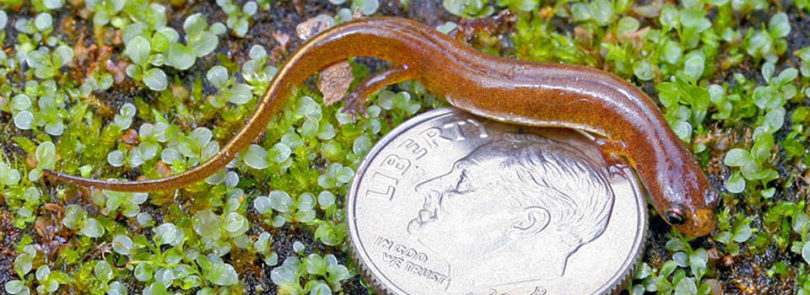Researchers from the University of Georgia Warnell School of Forestry and Natural Resources weren’t looking for anything new when they went exploring in the northeast part of the state. But they ended up making a big discovery of a tiny animal, finding a new species of salamander that could change what scientists know about some amphibians.
The newly discovered salamander, which is the second-smallest salamander species in the U.S. and one of the smallest in the world at just two inches long, is now under study by a diverse group of researchers from several U.S. colleges. The team is searching for more of the salamanders, which are detailed in a new paper appearing in the Journal of Zoology.
The discovering research team consists of Carlos Camp, professor at Piedmont College; Joe Milanovich, Warnell graduate student; Bill Peterman, University of Missouri graduate student; Trip Lamb, professor at East Carolina University; John Maerz, assistant wildlife professor at Warnell; and David Wake, professor at the University of California Berkeley.
The initial discovery came in spring 2007 near Toccoa, Ga., when Peterman and Milanovich stumbled across it while collecting another species of salamander in Stephens County. They knew they’d found an animal not known in that region but did not yet know it was a new species. Milanovich works with Maerz, a Warnell assistant professor of wildlife, and called him. Maerz advised them to take the salamander to Camp at Piedmont College, who recognized it as a new species. Lamb, a professor at East Carolina University, used genetics to confirm the new species and establish its relationship to other species in the region.
After the students found the first salamander, a female with eggs, in a creek, researchers went back repeatedly looking for others. That is when Maerz’s then 10-year-old son Jack and Milanovich found the first male specimen. The research team has found several individuals at the original site, including larvae, and they have found the new species at two other nearby locations in Georgia. Collaborators also found the species at a nearby site in South Carolina.
This discovery, according to Maerz, could yield exciting new information on the evolution of stream salamanders in this region.
“Whenever you find something new, it has the potential to change what we know about a range of related species,” he said. There are more than 560 species of salamanders worldwide, and approximately 10 percent are found in Georgia.”
But that’s not the only reason Maerz is excited. The new species was found in a well-traveled area in the middle of a creek right next to a road, almost hidden in plain sight.
“It is truly a once-in-a-lifetime opportunity to be involved in such a big find, particularly one right in our backyard,” Milanovich said. “The fact that it is such a unique animal makes it all the better and gives us more opportunity to continue to learn about the species. One of the best parts of being involved with this project is the collaboration that has come out of the species description, so I am excited to continue working with the other coauthors as we keep unpeeling the onion of U. brucei.”





